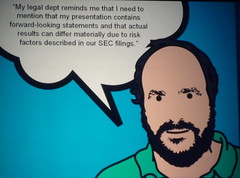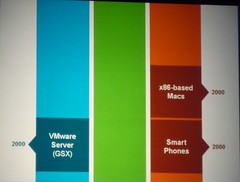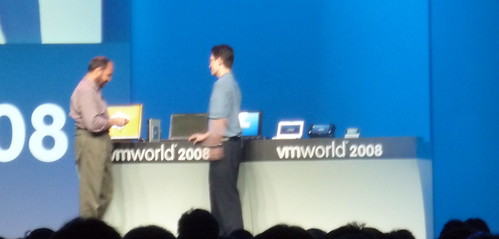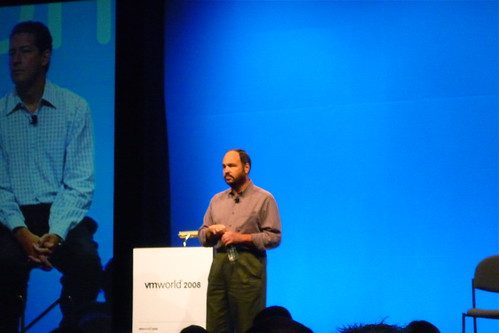Welcome to the Virtualization.come liveblog of the VMworld 2008 Keynote with CEO Paul Maritz.
[Updated with Q&A and more pictures]
[8.09] The program is starting. A video with testimonials from eBay, Qualcomm and the likes is on the big screens. There’s 14.000 people in the room ready for the first big keynote of the new CEO.
[8.10] The theme of the conference and the keynote is “Virtually anything is possible”.
[8.11] Paul Maritz takes the stage. Since VMware is now a public company, a disclaimer about forward looking statements is projected on the screen.
[8.12] 2008 is the occasion of two anniversaries: the 10th anniversary of VMware, and Paul Maritz stated working 30 years ago. Over the last three decades he’s seen several big “tsunamis” in IT. He’s looking forward to the next waves.
[8.13] Maritz recognizes two big forces, centralized and decentralized IT. Both have their strenghts and weaknesses. VMware brings the best of both: central, easy management, and a rich, customized user experience.
[8.14] Martiz spend a big part of the 1990s as an evangelist of client-server computing (while at Microsoft), leading to a big proliferation of x86 servers around the world.
[8.16] At the same time during the mid 1990s, the world wide web emerged, providing a rich yet decentralized user experience.
[8.17] Maritz recognizes the contribution of Diane Greene and Mendel Rosenblum, who founded VMware in 1998 and recently left the company.
[8.18] The roots of VMware are in the first product, VMware Workstation, a client-side product with extremely clever engineering.
As CPUs got more powerful, VMware introduced server products, the first being VMware GSX in 2000.
[8.19] The success of server virtualization made the VMware Infrastructure possible in 2004, to address the management issues that arose from an increasing number of servers, virtualized and physical.
Over the last few years, new application frameworks have emerged merging centralized computing and rich end user experiences. Examples are AJAX, RoR, Python-based frameworks like Django, ..
[8.21] VMware has continued to invest in client-side computing. like VMware Fusion in 2007 – lowering the barrier of Macs to enter into most corporate environments.
Nowadays, in 2008, the big buzzword is “cloud”. Paul Maritz says everyone’s got “cloud fever”.
We’re moving fundamentally away from a client-centered world. The applications and services get more flexible, and move around between places and devices. This requires the IT environments to be managed as a giant environment – a cloud.
[8.23] VMware is responding to this trends with three initiatives: Virtual Datacenter OS, vCloud Initiative, vClient Initiative.
The driving forces:
- Internal cloud – IT departments are forced to use their resources and applications even more efficient and efficiently.
- Scaling outside the firewalll – Making the connection between the internal cloud and external cloud providers in public datacenters. (such as Amazon EC2, ..)
- Solving the “desktop dilemma”
The first announcement is the formal announcement of the “virtual datacenter OS” – a new level of abstraction that separates the underlying infrastructure from the application workloads, to create a self-healing, self-managing elastic compute cloud.
[8.27] Several collaborations made this vCompute, vCloud, … initiatives possible. The first one is a collaboration between Intel and VMware.
Intel Xeon 7400 series provide the next generation of FlexMigration technology, making VMotion between heterogeneous CPUs possible.
Cisco formally announces the first third-party virtual switch for the Virtual Infrastructure.
vStorage: disaster recovery collaboration with lots of storage vendors to enable Site Recovery Manager. Up on the slide now: 3par, Falconstore, Compellent, IBM, Dell EqualLogic, EMC, Netapp, HP, Lefthand, Xiotech and Netapp.
[830] vApps: extending the Virtual Appliance approach. Initial support from IBM, SAP and Novell. vApps describes collections of appliances (for multi-tiered applications), and their service level properties. This metadata enables the VDC OS to provide service levels to this collection of apps.
[8.33] New management services to help manage this extensive datacenter OS. VirtualCenter becomes vCenter: a framework into which new plugins that extend the services can be integrated. It also interacts with third party management software from BMC, CA, HP, IBM Tivoli, …
[8.36] The strategic, business benefits of a VDC-OS, according to VMware:
- Increase infrastructure efficiency with standardized management and efficient use of resources
- Increase application agility with simple provisioning, repurposing and zero downtime
- Enable business driven IT, whith shorter response times, quick disaster recovery, pay-for-usage models and reduced energy and real estate needs
[8.39] Even though this all sounds quite new, the needs for this cloud are here today. VMware hopes to be able to make the internal infrastructure, the “internal clooud” to be more compatible with external cloud providers.
Service provider partners today: more than 100. On the slide: BT, Verizon, Sungard, Savvis and T Systems. They provide compatibility with workloads defined as vApps.
[8.43] Technology preview of the vCloud on stage. Demo: an application has an SLA with a response time under 4 seconds. If the SLA is not met, the app will be pushed to an external cloud provider. The SLA is defined using the Appspeed component of vCenter
[8.48] Extra load is being generated. The internal VM can’t meet the SLA anymore, so a VM is being launched in the cloud to which the load is diverted.
Interesting demo, but a bit hard to grasp from a distance, not as impressive as continuous availability last year (now called VMware Fault Tolerance). This will be cool nonetheless.
[8.50] Now on to the Desktop Dilemma. IT wants to bring down costs, the users want to be mobile, use macs, don’t want the info locked up in a single device, want the info anywhere, anywhere, and in a rich experience. This will be the VMware View announcement.
Data lifetime spans device lifetime, so it should not be lockup up in a single device.
VMware has always continued to invest in client-side products.
[8.53] The first solution to this problem was the VMware VDI concept. This way, the users workspace was no longer tied to a single device.
[8.56] A next demo of VMware View. First they demo the existing VDM product on a thin client. There’s lots of other devices on the stage though. The VM is saved on a USB key, which is used to boot a laptop. They also demo improved 3D graphics support.
New announcement: codevelopment with Teradici to improve the remote desktop protocol.
The new product family of VDI products is going to be called VMware View.
[9.05] And with that, the keynote comes to an end. Paul Maritz seems to have forgotten the Twitter questions…
So that wraps up our first live keynote blog. Keep watching Virtualization.com for more updates from VMworld. A video overview of the keynote will be following soon.
Update: Some of the questions from the Q&A session afterwards:
Q: What do you see as the two major challenges for VMware in the coming years?
A: Paul Maritz – Several related challenges: Deepen and extend the value proposition of the products, and extend this to the cloud. The organisation needs to mature further to be able to deliver this into actual products. Maintain high quality, interact with the ecosystem around virtualization, mature as a partner. Reach out better to the community. Articulate this all to the customers.
Q: What about the threat posed by Red Hat/Qumranet/KVM
A: Paul Maritz – Open Source is a great phenomenon. Open sourcing ESX has been discussed already. First step is making ESXi free. They’re not religious about not supporting for instance Xen in the VDC framework.
Q: How does SRM fit in with the vCloud initiative. Will it not make SRM redundant?
A: vCloud federation complements SRM in a way that it facilitates DR for companies that have no external disaster site, to be able to get up and running faster on an external cloud.
Q: Is VMware becoming an OS company?
A: Paul Martiz – In a way. That’s why it’s explicitly called Virtual Datacenter Operating System. The name came from customers, who kept calling it a Datacenter OS.
It’s an OS in the sense that it abstracts the applciation loads from the underlying hardware. Not in a traditional OS/app sense, but it has lots of parallels with traditional OS’es, so the name does apply. The services and APIs can be used to deliver OS capabilities, to frameworks like Ruby on Rails, so that the underlying [JeOS] gets thinner and thinner in the complete framework.
Q: VMotion today is restricted to a network domain. Are you working on enabling this across networks and geographies?
A: Yes. On the storage side we need replication for this. On the network side you need stretched VLANs or interaction with routing tables. VMware is working with its partners to provide this capabilities.
Q: Are there initiatives coming for non-profits and educational customers?
A: Today there is already academic pricing for US schools. There also will be an academic program to provide software to schools around the world, which will later be extended to non-profits.
No timeframe on this yet.
Q: Are you going to further expand your product line to the Mac? Specifically ESX and ACE.
A: More on this in the Fusion / ACE sessions..
Q: The issue with update 2 (the timebomb bug) was a wake-up call that VMware is becoming a single point of failure for the complete datacenter. How do you address this very real concern?
A: Paul Maritz: We’re continously maturing and improving our QA and security procedures. The issue with update 2 was amateur hour. We do take this serious and try to make sure this never happens again.
[NB: There’s a session with Paul Maritz on this issue tomorrow afternoon.]
Q: It seems like everytime I dream about a new feature I’d like to see in VMware, you guys come up with it. However, one big issue with the vCloud initiative is time drift in application. How will you fix this?
A: It is a big dilemma. On the Linux side we’re submitting patches to the kernel to improve this. Paravirtualization also helps OS’es communicate with the hypervisor to avoid timing issues.
Q: With the VDI solution where the desktop can reside on different devices. How’s the licensing going to work out? Per client? Per devices?
A: Not worked out yet.
Q: When are you going to release a VirtualCenter client for Linux?
A: Paul Martiz – I think VirtualCenter as a modern application should be OS independent. It’s not out of the question, but it’s hard work, not in a defined roadmap yet.



